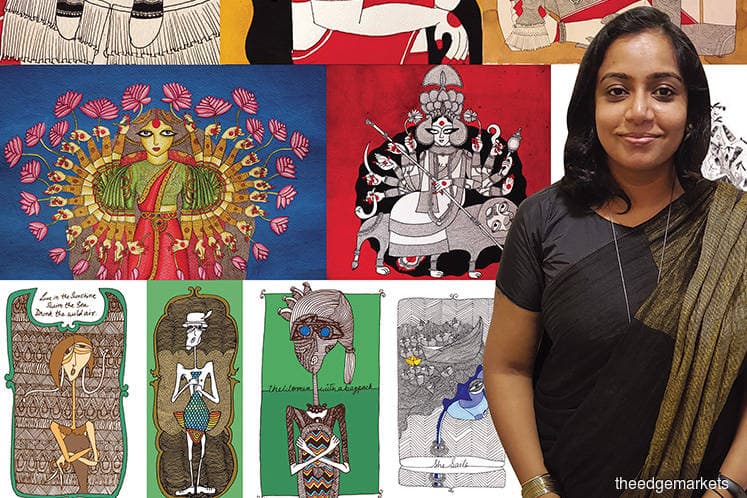
This article first appeared in Personal Wealth, The Edge Malaysia Weekly on January 1, 2018 - January 7, 2018
As a young girl, the art I admired were not paintings on canvas or frames hanging on the walls. Instead, it was in the form of my grandmother’s underrated handspun plaid cotton saree — a speciality fine weave that hails from the Chettinad province in Tamil Nadu, India.
The esoteric precision of the weave in colours of emerald and rubies as well as the placement of motives, shapes and patterns imbued with folklore, magical realism and mysticism set the stage for my love of paintings by Indian artists.
Thanks to the internet, art galleries all over the world have become accessible to us, literally at our fingertips, and brought about democratisation of the passion asset that would otherwise be out of reach to someone earning a journalist’s salary. I would spend hours browsing and scrolling webpages just to gaze at the works and read about the investment returns and substantial prices paintings by famed artists such as N S Bendre, Bhupen Khakhar, Sayed Haidar Raza, Raja Ravi Varma and
M F Husain fetch at auctions globally.
For example, an untitled painting of abstract artist Vasudeo S Gaitonde was purchased for US$4,415,008 at a Christie’s auction in Mumbai in 2015. According to art market intelligence firm Artery India, it was the most expensive Indian artwork sold since 1965.
While these exclusive works have continued to fetch millions in the global markets, the demand for more affordable and exclusive original works as well as a market for limited edition prints and artist multiples have begun burgeoning in parallel. This trend has inadvertently resulted in a boom in art sales at online marketplaces.
According to the Art Basel and UBS Global Art Market Report, online sales of art and antiques were estimated to have reached US$4.9 billion in 2016 — an increase of 4% year on year and accounting for almost 9% of the global art and antiques market by value. According to Saatchi Art, a leading online art gallery, the number of online art buyers who have bought more than a single artwork up to May last year was at 65%, up from 63% in 2016.
Saatchi’s Invest in Art 2017 Report: Emerging Artists to Buy Now also found that the majority of online art purchases were US$5,000 (79% in 2017, up from 78% in 2016). And the report adds that there is no better time to invest in emerging artists than now.
“Not only do you have the chance to be among the first to buy from a future art star, but there tends to be much greater access to an artist’s work — both in terms of price and availability — at the start of his career. In addition, the risk of forgery, which can be a concern at the top end of the market, is virtually non-existent,” says Saatchi.
Long story short, such innovative avenue opened up a whole new chapter for an art enthusiast like me. Four years ago, while incessantly browsing to de-stress after filing what felt like the 100th article for the day, I stumbled upon Goa-based miniature artist Srijan Jha.
Much of Srijan’s narratives are rooted in Indian architecture, tribal and folkloric art such as pattachitra (a type of scroll painting from Odisha) and gond paintings. This enthused me to engage him over social media.
While Srijan’s works were perfectly priced for an emerging artist, his originals are still out of my reach. Among his many captivating paintings is The Whimwell, a miniature canvas consisting of 171 meticulously painted animals, which cost INR117,000. So, when he announced that he would be issuing limited issues of his ink and acrylic original depicting Mahishasura Mardini (an incarnation of goddess Durga), I was beyond ecstatic.
Until then, my only foray into acquiring anything that resembles an artwork were handloom sarees — which happens to be a very undervalued skill — that were a much more affordable alternative to quench my thirst for art to call my own, albeit having little to no investment value.
Still lightly intoxicated with my limited edition print, I have made a pledge in 2018 to set aside a small amount of my monthly salary to purchase little pieces of art from artists of the time.
Although to me, the money involved is secondary to gaining possession of a unique piece of art, no one really wants to lose money on their investments. So, while art pundits argue that art investments have demonstrated very low correlation with other financial asset classes, making it a strong and stable investment when the money market is in turmoil, it is crucial to ensure that due diligence is done and you are getting a good deal.
In the case of art, it is important to know the significance of the artist and the art; the artwork’s provenance, history and documentation; and that you are getting fair value for it.
There are plenty of online art dealerships and galleries out there providing for different categories of artists. Saatchi, India’s bestcollegeart.com and the UK-based The Edition Shop are some of my go-to platforms to scour for original artworks. Likewise, it is fairly convenient to deal with artists directly using social media platforms.
Some of the pieces that I hope to eventually get my hands on are by artists such as Sukanta Dasgupta, Michael Nauert, Abhishek Singh, Oscar Pedreros, Auke Mulder, Shilo Shiv Suleman and Gunjan Aylawadi.
Save by subscribing to us for your print and/or digital copy.
P/S: The Edge is also available on Apple's AppStore and Androids' Google Play.